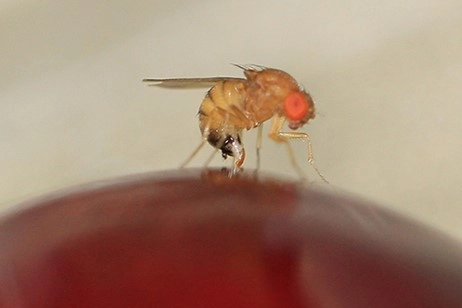An internationally supported project is paving the way for an innovative strategy to reduce the impact of the fruit fly on small fruits.
Chile is strengthening its leading role in South America in applying biotechnology for sustainable pest control in fruit growing. During the Second Coordination Meeting of the FAO/IAEA project dedicated to improving mass-rearing and release techniques of Drosophila suzukii for SIT programmes, held in Mendoza from 3 to 7 November 2025, the Fundación para el Desarrollo Frutícola (FDF) presented the progress of its Sterile Insect Technique (SIT/TIE) programme.
Carolina Yáñez, agronomist of FDF’s Quarantine Entomology Area, outlined the status of the Chilean initiative, launched with support from the International Atomic Energy Agency (IAEA) and in technical cooperation with ISCAMEN, the Institute for Food Quality and Health of Mendoza.

SIT: targeted and sustainable biotechnology
SIT involves releasing sterile males which, by mating with wild females, prevent reproduction and help reduce pest populations. It is a species-specific technique, compatible with integrated production principles and capable of reducing dependence on insecticides. At the international level, the FAO/IAEA programme promotes the adoption of SIT through operational manuals, quality protocols and shared guidelines.
The Chilean project is in an advanced stage of preparation: protocol validation, logistical planning, obtaining the necessary permits, and adapting the technology to local agroecological conditions. The sterile material will be supplied by ISCAMEN’s Santa Rosa biofactory, while FDF’s quarantine laboratory in Quilicura will carry out quality controls on sterility, emergence, flight ability and insect vitality.
Strategic cooperation with Argentina
Cooperation with ISCAMEN represents a key operational asset: the Argentine institute has state-of-the-art infrastructure for the rearing and irradiation of insects, as well as solid experience applying SIT in South American agricultural contexts. This technical exchange accelerates learning and ensures high standards for field trials.
Meanwhile, the Chilean Agriculture and Livestock Service (SAG) maintains an active programme for surveillance and containment of D. suzukii, classified as “present with restricted distribution” in the main cherry-growing regions: O’Higgins, Maule, Ñuble and La Araucanía. Coordination with Argentina’s SENASA within the FO-AR framework further strengthens cross-border technical synergies.
Data in hand: monitoring and early results
From 2022 to 2025, FDF implemented a monitoring network in 50 cherry orchards to assess population density and calibrate future release strategies. During the 2024–25 season, an increase in pest pressure of 0.35 CTD was recorded, with a predominance of female specimens, highlighting the urgency of implementing solutions such as SIT to reduce reproductive capacity.
The activities focus on the regions with the highest cherry-growing potential, where the introduction of SIT will complement integrated pest management (IPM) techniques, including physical coverings, agronomic practices and targeted plant protection.
Towards the first field releases
In the first year, the project has already completed key phases: development of quarantine protocols, definition of sterile material packaging and transport, and the start of authorisation procedures with SAG. The goal is to begin the first controlled releases in Chilean territory once all technical and regulatory checks are completed, following the best practices established by the IAEA.
According to Carolina Yáñez, trials conducted in Argentina by ISCAMEN and INTA, with which FDF collaborates actively, confirm the effectiveness of SIT both in laboratory and open-field conditions, paving the way for its application on a regional scale across the Southern Cone.
A new frontier for cherry protection
With Drosophila suzukii increasingly threatening cherries and small fruits, Chile aims to reduce the use of pesticides through biotechnology. The adoption of SIT represents a paradigm shift aligned with international market demands: cleaner production, greater traceability and environmental sustainability. The synergistic work between public institutions, research centres and cross-border cooperation strengthens the path toward a more resilient and competitive fruit sector.
Source: www.diariofruticola.cl
Image source: Agroscope
Cherry Times – All rights reserved













